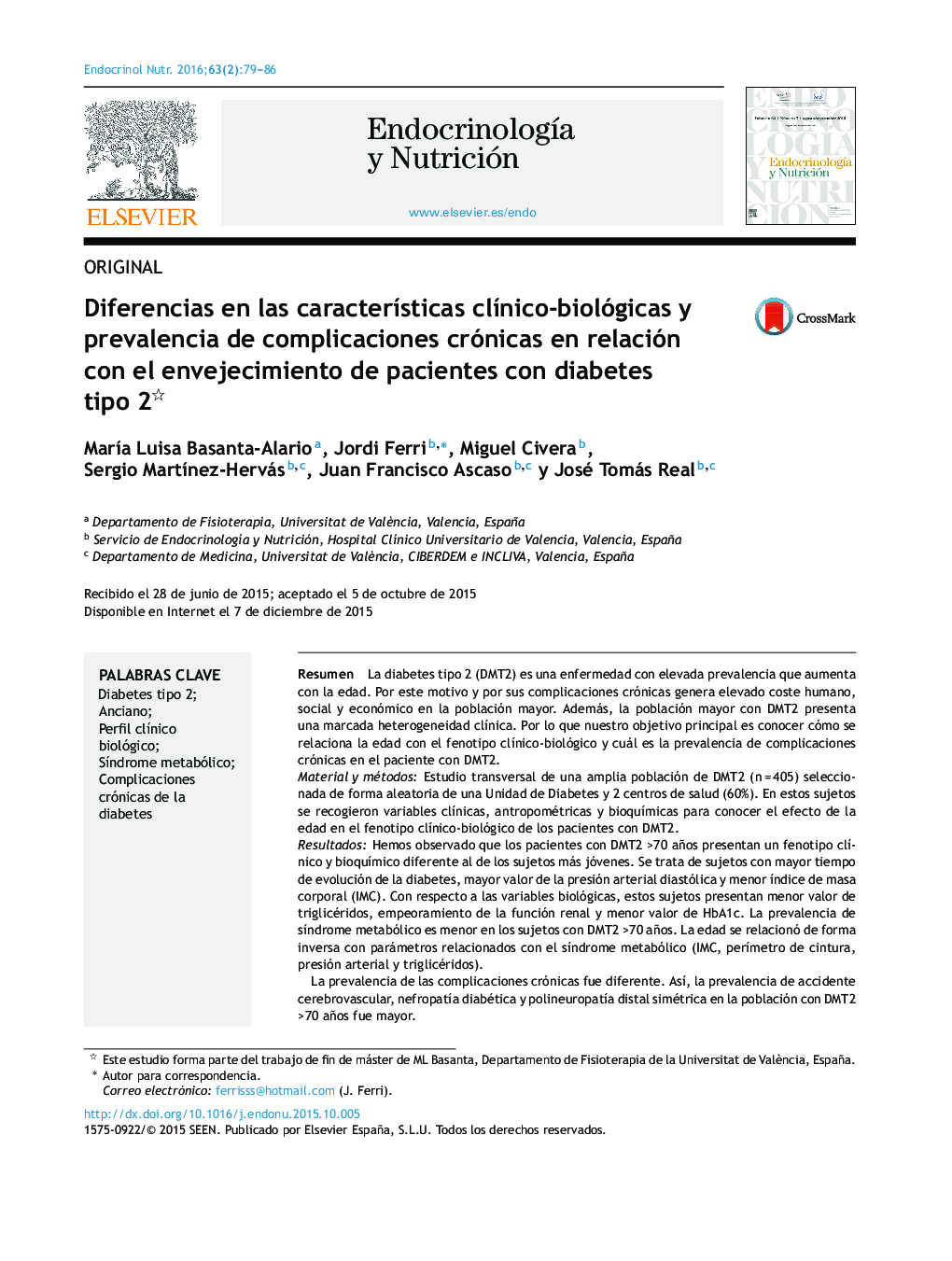| کد مقاله | کد نشریه | سال انتشار | مقاله انگلیسی | نسخه تمام متن |
|---|---|---|---|---|
| 2773309 | 1152128 | 2016 | 8 صفحه PDF | دانلود رایگان |
ResumenLa diabetes tipo 2 (DMT2) es una enfermedad con elevada prevalencia que aumenta con la edad. Por este motivo y por sus complicaciones crónicas genera elevado coste humano, social y económico en la población mayor. Además, la población mayor con DMT2 presenta una marcada heterogeneidad clínica. Por lo que nuestro objetivo principal es conocer cómo se relaciona la edad con el fenotipo clínico-biológico y cuál es la prevalencia de complicaciones crónicas en el paciente con DMT2.Material y métodosEstudio transversal de una amplia población de DMT2 (n = 405) seleccionada de forma aleatoria de una Unidad de Diabetes y 2 centros de salud (60%). En estos sujetos se recogieron variables clínicas, antropométricas y bioquímicas para conocer el efecto de la edad en el fenotipo clínico-biológico de los pacientes con DMT2.ResultadosHemos observado que los pacientes con DMT2 >70 años presentan un fenotipo clínico y bioquímico diferente al de los sujetos más jóvenes. Se trata de sujetos con mayor tiempo de evolución de la diabetes, mayor valor de la presión arterial diastólica y menor índice de masa corporal (IMC). Con respecto a las variables biológicas, estos sujetos presentan menor valor de triglicéridos, empeoramiento de la función renal y menor valor de HbA1c. La prevalencia de síndrome metabólico es menor en los sujetos con DMT2 >70 años. La edad se relacionó de forma inversa con parámetros relacionados con el síndrome metabólico (IMC, perímetro de cintura, presión arterial y triglicéridos).La prevalencia de las complicaciones crónicas fue diferente. Así, la prevalencia de accidente cerebrovascular, nefropatía diabética y polineuropatía distal simétrica en la población con DMT2 >70 años fue mayor.ConclusionesHemos definido el perfil clínico-biológico del paciente con DMT2 > 70 años que acude a centros sanitarios. Los sujetos con diabetes tipo 2 >70 años no presentan el fenotipo de síndrome metabólico observado en los que tienen DMT2 más jóvenes. Además, la prevalencia de accidente cerebrovascular, nefropatía y de polineuropatía distal simétrica es mayor en los pacientes con DMT2 > 70 años.
Type 2 diabetes mellitus (T2DM) is a chronic, highly prevalent disease that increases with age. Because of this, and due to its chronic complications, T2DM causes high human, social, and financial costs. In addition, the elderly population with T2DM has a marked clinical heterogeneity. Therefore, our main objective was to analyze the relationship of age with the clinical and biological manifestations of the disease and the prevalence of chronic complications in patients with T2DM.Material and methodsA cross-sectional study of a large population with T2DM (n = 405) randomly selected from a Diabetes Unit and 2 health care centers (60%). The clinical, anthropometric, and biochemical variables of the subjects were collected using standard methods to assess the effect of age on the clinical and biochemical phenotype of patients with T2DM.ResultsWe have noted that patients with T2DM > 70 years old have a clinical and biochemical phenotype different from younger subjects (<60 years) including longer times since diabetes onset, higher diastolic blood pressure levels, and lower body mass index (BMI) values. As regards to biological variables, these patients have lower triglyceride levels, impaired kidney function, and lower HbA1c values. Prevalence of metabolic syndrome is lower in patients with T2DM > 70 years of age. Age was inversely related to parameters associated to metabolic syndrome (BMI, waist circumference, blood pressure, and triglyceride levels).ConclusionsWe have defined the clinical and biochemical profile of patients with T2DM > 70 years attending health care centers. In addition, the prevalence of stroke, kidney disease, and distal symmetrical polyneuropathy is higher in patients with T2DM >70 years as compared to younger patients (<60 years).
Journal: Endocrinología y Nutrición - Volume 63, Issue 2, February 2016, Pages 79–86
